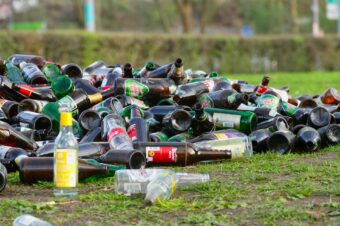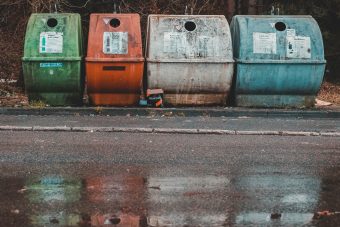
Numerous analyses of various social aspects point to the fact that the coming decades will bring us an increase in the demand for resources. Considering the exploitation of natural resources that are not unlimited, the need for a different approach becomes a prerequisite for the sustainable survival of the planet and its inhabitants. Data show that in the next 40 years, the global consumption of materials such as biomass, fossil fuels, minerals, and metals could double. By increasing their use, waste also grows due to this approach. It is also predicted that the quantity of generated waste could increase by 70 per cent by 2050.
The human relationship with the environment, in general, is reduced to collecting benefits from it, not considering the needs of other inhabitants of the planet today and even less providing a future perspective.
A prerequisite for a sustainable future
During the life of the human species so far, the attitude towards what nature offers has been reduced to the principle of take-use-throw away. Although early civilizations did not contribute to the degradation of the environment in the way that humans do today, they laid the foundation for the treatment humans have been using in recent centuries. It is the so-called linear economic model, which needs to be eliminated if we want to make life on the planet sustainable for future generations.
The law of nature says that everything is connected, pointing to the fact that the problem of excessive consumption of resources does not only mean their depletion. Closely related problems are the world, which has seen the degradation of biodiversity and acceleration of climate changes, poverty, hunger, injustice, unrest among people and others. Considering the aforementioned, the Sustainable Development Goals of the 2030 Agenda were adopted at the UN summit in September 2015 and officially into force on January 1, 2016. Seventeen goals are interconnected in a cause-and-effect relationship.
IN FOCUS:
- GREEN CITY DEVELOPMENT – A NEW APPROACH TO URBAN PLANNING AND SAVINGS
- THE IMPORTANCE OF NATIONAL ENVIRONMENTAL PROTECTION PLANS
- NOXATEST THE GREEN FUTURE OD DIAGNOSTICS
Although none of the goals specifically refers to the circular economy, its essence is particularly incorporated into goal 12 – responsible consumption and production. This goal promotes the need for sustainable and efficient use of natural resources, proper management of chemicals, significant reduction of waste generation and its processing and sustainable public procurement.
In addition to this goal, six more should be highlighted that are also directly related to the implementation of the circular economy – goal 7 – affordable and renewable energy; goal 8 – decent work and economic growth; goal 11 – sustainable cities and communities; goal 13 – climate action; goal 14 – life below water; and goal 15 – life on land.
As a new economic model that should replace the linear one, the circular economy rests on the principle of maximum reuse of materials from products at the end of their life cycle, with as little use of new resources as possible, as the main source of economic growth. This model strives to recover all waste material in the process of new production as soon as resources are used sustainably and efficiently, reduces the negative impact on the environment, also generates financial savings and new business opportunities – waste from one industry becomes raw material for another, i.e. waste does not exist.
The circular economy views products differently, taking into account how they are designed, how recyclable they are, the way they are produced and what impact they have on nature.

Speaking of the circular economy and our country, the establishment of a strategic framework began in 2019, when an ex-ante analysis of the effects of the circular economy was drafted, which showed that a separate public policy document is needed covering the circular economy.
Following the results of the analysis mentioned above and based on the Republic of Serbia’s Planning System, the Ministry of Environmental Protection initiated the development of the Circular Economy Development Programme in Serbia, covering the period from 2022 to 2024. The overall goal of this document is to create a stimulating environment for the development of the circular economy to support the green transition in the Republic of Serbia. To accomplish this overall goal, five individual goals are set, as are measures and activities that will be implemented from 2022 to 2024.
Individual goals are as follows:
1. supporting the economy in the transformation to a circular business model
2. supporting local governments in creating circular communities
3. improving the waste management system through more efficient use of waste in the circular economy
4. supporting the implementation of green public procurement and voluntary instruments related to environmental protection
5. raising the awareness of the public and educational institutions about the concept of circular economy.
A SWOT analysis was used in developing this Programme to understand the current situation better and identify further planned activities. Among other things, this analysis determined weaknesses in our country regarding the circular economy. Waste management was identified as the main weak point in the entire system, considering the inadequate application of regulations, the poor condition of communal infrastructure, the small percentage of primary waste selection, the absence of penalties and education of the population and others. Specific problems are listed in more than 30 points and include an underdeveloped circular model of single-use plastic product management and the use of more sustainable materials, low utilization of residues from the production process and inadequate exchange of information about their possible utilization among companies, as well as the lack of an adequate system for the reuse and recycling of non-hazardous construction waste, the lack of suitable waste management operators in the market, the impossibility of delivering waste in small quantities and others.
Prepared by: Katarina Vuinac
Read the story in the new issue of the Energy portal Magazine CIRCULAR ECONOMY



